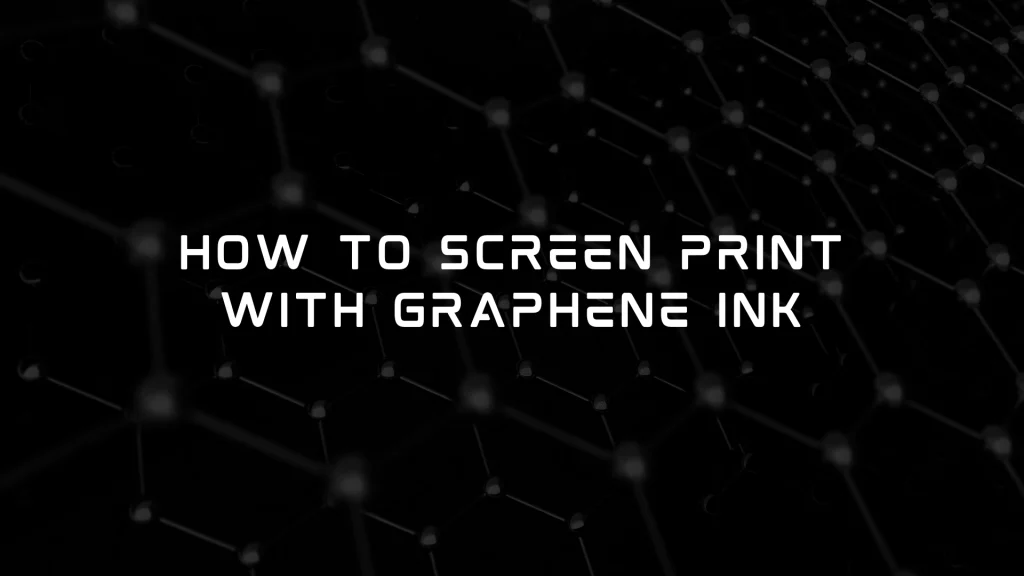Screen printing stands as a time-honoured method for transferring designs onto many surfaces. Its roots trace back centuries, proving its lasting appeal. From simple t-shirt designs to complex industrial markings, screen printing offers great control and a thick ink deposit. This makes it a popular choice across countless industries.
Now, imagine this versatile method joined with a new, advanced material: graphene ink. Graphene ink is special. It boasts unique properties, like being highly conductive and super strong. This makes it a true game-changer. It holds the power to change how we make printed electronics, smart textiles, and other high-tech items.
This guide will show you how to screen print with graphene ink. We will cover every step in detail. You will learn about preparing your setup, applying the ink, and finishing your printed items. Get ready to explore the exciting world of graphene screen printing.
Understanding Graphene Ink for Screen Printing
What is Graphene Ink?
Graphene ink contains tiny particles of graphene. Graphene itself is a single layer of carbon atoms, arranged in a honeycomb pattern. Think of it as graphite, but just one atom thick. This flat structure gives graphene amazing properties. It is the thinnest, strongest, and most conductive material known.
Graphene ink uses different forms of graphene. These include graphene nanoplatelets (tiny stacks of graphene layers) or reduced graphene oxide. The type depends on the ink’s intended use. You can find graphene inks that are water-based or solvent-based. Each has its own drying times and uses.
Using graphene ink in screen printing offers many benefits. It makes printed circuits highly conductive. These circuits can also be very tough and flexible. This versatility opens doors for new products, from bendable sensors to wearable tech.
Properties Relevant to Screen Printing
Graphene inks have specific traits that matter a lot for screen printing. How thick or thin the ink is, known as its viscosity, is key. It needs to flow just right through the screen mesh. If it is too thick, it won’t pass through. If it is too thin, it might spread too much.
The size of graphene particles also affects your print. Smaller particles let you use finer meshes. This means you can print very detailed designs. Larger particles need coarser meshes. The ink’s drying characteristics are important too. Some inks dry quickly at room temperature. Others need heat or UV light to set properly.
Graphene ink also needs to stick well to different materials. This is called adhesion. It must bond firmly to your chosen substrate, like plastic film or fabric. This ensures the printed part lasts a long time and works as it should.
Essential Equipment and Materials
Screen Printing Setup
You will need the right tools for successful screen printing with graphene ink. A screen printing press holds your screen steady. You can choose a simple manual press for small jobs. For larger runs, an automatic press might be better. The press ensures exact alignment for each print.
The screen mesh is vital. Polyester mesh is common. Its thread count is important; a higher count means smaller mesh openings. This lets you print finer details with smaller graphene particles. Using the right emulsion on your screen creates the stencil. This emulsion blocks ink where you do not want it.
Your squeegee pushes the ink through the mesh. Its material, hardness (durometer), and edge shape affect how much ink transfers. A sharp, durable edge is best for a crisp print. Graphene ink works on many substrates, such as PET film for flexible circuits, paper for smart labels, or various textiles.
Graphene Ink and Related Supplies
Picking the right graphene ink formulation is crucial. It depends on what you are making. For example, a bendable sensor needs a flexible ink. A heated element might need a more robust, high-temperature ink. Always check the ink’s technical datasheet.
Sometimes, you might need special adhesives or binders. These can improve the ink’s bond to tricky surfaces. They also help if you are mixing custom ink blends. Cleaning up after printing is also part of the process. You will need suitable cleaning fluids for your screens and equipment. These liquids help remove graphene ink residue.
Finally, curing equipment is necessary. Graphene ink often needs heat to become fully conductive. This means you might use a convection oven or a heat press. Some inks use UV light for curing, requiring a UV curing system. Always follow the ink maker’s advice for curing times and temperatures.
The Screen Printing Process: Step-by-Step
A) Screen Preparation
Step 1: Getting your screen ready is a key step. First, clean your screen mesh thoroughly. Remove any dust, grease, or old ink using a screen degreaser. A perfectly clean screen ensures the photo-emulsion sticks well. Next, apply a layer of photo-emulsion evenly to both sides of the screen. Let it dry completely in a dark, dust-free place.
Step 2: Once dry, you will expose the screen to light. Place your artwork, printed on a clear film positive, onto the coated screen. A special exposure unit shines light through your artwork. The light hardens the emulsion where the artwork is clear. Where the artwork is black, the emulsion stays soft.
Step 3: After exposure, wash out the soft, unexposed emulsion with water. This creates your stencil, the open areas through which the ink will pass. Let the screen dry fully before printing.
Actionable Tip: Proper screen tension is vital for consistent ink transfer. A tightly tensioned screen prevents sagging and ensures uniform prints.
B) Ink Application and Printing
Step 1: Begin by checking your graphene ink. Some inks need a good stir before use. Make sure it is at the right temperature and viscosity, as the ink maker suggests. Then, carefully load a suitable amount of ink onto the top edge of your screen. Do not overload it.
Step 2: Set up your print parameters on the press. Adjust the squeegee pressure for a clear print. The squeegee angle and speed also matter for smooth ink transfer. A ‘flood stroke’ helps push a thin layer of ink over the stencil before the print stroke. This keeps the mesh clear.
Step 3: Do some test prints on scrap material first. Check the conductivity and how well the ink coverage looks. Make small changes to your pressure, angle, or speed until the print is perfect.
Real-World Example: Graphene ink successfully makes highly conductive traces on flexible plastic circuits. These circuits are used in many new devices because they can bend and twist without breaking the connection.
Curing and Post-Processing
Curing graphene ink correctly is crucial. This step unlocks its full conductivity and makes it durable. The method depends on your ink type. Thermal curing uses heat from an oven or heat press. UV curing uses ultraviolet light. Photonic curing uses very short bursts of intense light.
Always follow the ink manufacturer’s specific curing guidelines. This means sticking to the right temperature and time. After curing, you should test your printed item. Check its conductivity using a multimeter. Also, check for good adhesion by gently trying to scratch off the ink.
Sometimes, you might need extra steps. An overcoating layer can protect the graphene from damage. Lamination can add further protection and flexibility. These post-processing steps ensure your graphene prints last and perform as expected.
Actionable Tip: Always follow the ink manufacturer’s specific curing guidelines. These instructions are key to getting the best performance from your graphene ink.
Troubleshooting Common Issues
Print Quality Problems
Sometimes, things do not go as planned when printing. You might see poor conductivity or uneven resistance. This could be due to too little ink or uneven pressure. Ink smearing or bridging (where lines connect that shouldn’t) often means too much ink or incorrect squeegee settings.
If your print has uneven ink coverage or poor resolution, check your screen mesh. The mesh count might be too low for the ink’s particle size. Or, your emulsion might not be thick enough. Adhesion failures mean the ink is not sticking to the substrate well. This can happen if the surface is not clean or if the ink needs a special primer.
Actionable Tip: Viscosity adjustments are often the first step in resolving print quality issues. Adding a little solvent can thin the ink, or letting some solvent evaporate can thicken it.
Curing and Performance Challenges
Incomplete curing is a big problem. It leads to poor conductivity, as the graphene particles are not fully connected. This often happens if the curing temperature is too low or the time is too short. Your graphene properties might even degrade during curing if the temperature is too high. This can burn the material, making it less effective.
Another challenge is substrate compatibility after printing and curing. Some materials might warp or shrink when heated. This can affect the printed design. Always test your substrate with the ink and curing process before a full print run.
Expert Quote/Reference: Research shows that “optimising the thermal treatment of graphene ink films greatly improves their electrical conductivity by removing residual solvents and increasing inter-flake contact.” This highlights the importance of precise curing.
Applications and Future of Graphene Ink Screen Printing
Current Applications
Printed Electronics: Graphene ink screen printing is already transforming various fields. In printed electronics, it creates flexible displays that can bend and roll up. It also makes thin, light sensors for many uses. RFID tags, found in many products, also use screen-printed graphene.
Smart Devices: Wearable technology benefits greatly. Think of smart clothes with sensors printed right into the fabric. Biomedical devices also use graphene ink. It helps create electrodes for health monitoring, being gentle on the skin. Smart textiles, from heated jackets to athletic wear with built-in sensors, are also growing areas.
Real-World Example: Screen-printed graphene electrodes are used in electrochemical sensors. These small devices can detect specific chemicals or biological markers quickly and accurately.
Future Trends and Innovations
The future of graphene ink screen printing looks very bright. Scientists are working on new ink formulations. These will offer even better conductivity, flexibility, and environmental safety. Imagine inks that cure instantly or work on even more unusual surfaces.
New substrate materials are also coming. These include even thinner films or more sustainable options like biodegradable papers. We will also see graphene ink printing combined with other advanced manufacturing methods. This could lead to complex, multi-layered electronic systems.
Data Point: The printed electronics market is projected to grow significantly in the coming years. This growth is driven largely by advanced materials like graphene, showing its rising importance.
Conclusion
Screen printing with graphene ink offers huge potential. We have covered the essential steps for successful printing. This includes choosing the right materials and carefully preparing your screen. We also looked at the vital curing process and how to solve common problems.
Remember, the right material selection, careful screen preparation, and precise curing are key. They ensure your graphene prints are both conductive and durable. Graphene ink is changing many industries. It offers new ways to make electronics, sensors, and smart products that are flexible and strong.
Final Actionable Tip: Do not be afraid to experiment with different ink settings and substrates. Talk to the NanoGraf team for expert advice. We can help you get the best results for your specific project.


